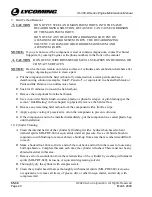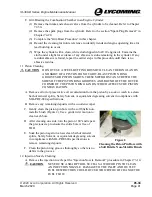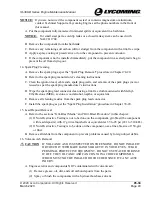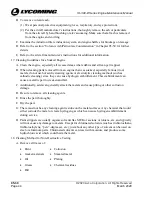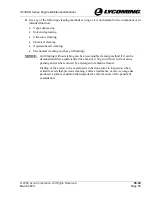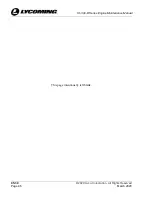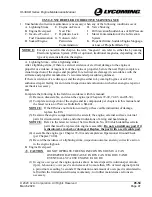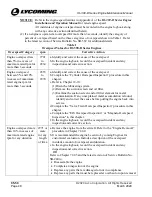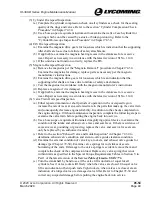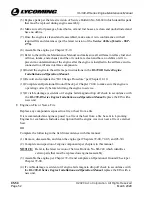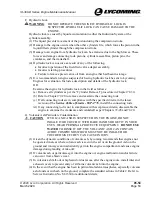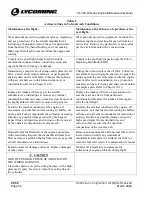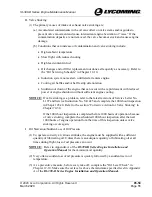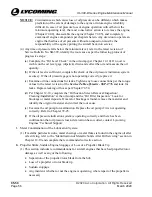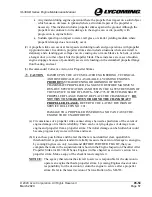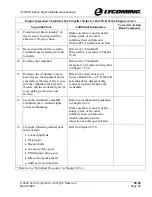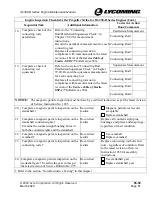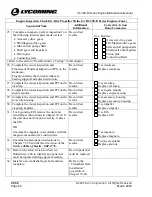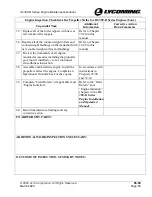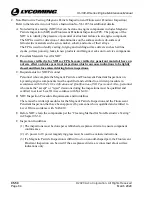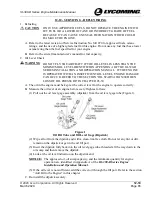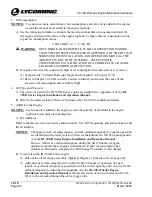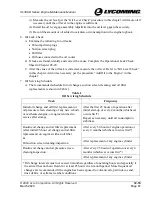
IO-390-D Series Engine Maintenance Manual
© 2020 Avco Corporation. All Rights Reserved
05-50
March 2020
Page 53
IO-390-D Series Engine Maintenance Manual
F.
Hydraulic Lock
WARNING
DO NOT OPERATE THE ENGINE IF HYDRAULIC LOCK IS
SUSPECTED. HYDRAULIC LOCK CAN CAUSE DAMAGE TO THE
ENGINE.
Hydraulic lock is caused by liquid accumulation in either the Induction System or the
cylinder assembly.
(1)
The liquid prevents movement of the piston during the compression stroke.
(2)
Damage to the engine occurs when the other cylinders fire, which forces the piston in the
liquid-filled cylinder through the compression stroke.
(3)
Damage to an engine from hydraulic lock can be extensive due to the high forces. These
forces can damage connecting rods, pistons, cylinder assemblies, piston pins, the
crankcase, and the crankshaft.
(4)
Hydraulic lock can occur as a result of any of the following:
•
Incorrect operation of the fuel drain valve adapter assembly.
•
Incorrect starting procedures.
•
Failure to remove preservative oil from an engine that had been in storage.
(5)
It is recommended an engine suspected of having hydraulic lock be sent to Lycoming
Engines for evaluation. Include a description and details of the hydraulic lock.
OR
Examine the engine for hydraulic lock in the field as follows:
(a)
Remove all cylinders as per the “Cylinder Removal” procedure in Chapter 72-30.
(b)
Refer to Chapter 72-20 to remove and examine the connecting rods.
(c)
If all connecting rods are in compliance with the specified criteria in the latest
revision of the
Service Table of Limits - SSP-1776
, install the connecting rods.
(d)
If any connecting rod is not in compliance with acceptance criteria, disassemble the
engine to examine the crankcase and crankshaft as per Chapters 72-05 and 72-20.
G.
Volcanic Ash/Particulate Contamination
CAUTION
IF VOLCANIC ASH IS SUSPECTED ON THE ENGINE, DO NOT
INHALE IT OR TOUCH IT WITH BARE HANDS OR GET IT IN YOUR
EYES. WEAR PERSONAL PROTECTIVE EQUIPMENT.
DO NOT USE
WATER
TO RINSE IT OFF. THE VOLCANIC ASH CAN CONTAIN
ACIDIC COMPOUNDS WHICH MUST NOT BE INHALED OR
TOUCHED SINCE THEY CAN CAUSE INJURY.
(1)
Given the dynamic conditions of volcanic ash, Lycoming recommends that engines not
be operated in areas where volcanic ash is seen in the air or on the ground. Ash on the
ground and runways can inadvertently get into the engine compartment and cause engine
damage during landing or take-off.
(2)
If volcanic ash or particulates get into the engine oil, engine malfunction and/or failure
can occur from abrasive wear.
(3)
In volcanic ash fall-out or high sand or dust areas, after the engine cools, install inlet and
exhaust covers to prevent entry of airborne volcanic ash into the engine.
(4)
In the event that the engine has been in particulate-laden atmospheres, especially volcanic
ash clouds or with ash on the ground, complete the standard actions in Table 2. Refer to
Service Instruction No. SI-1530 for additional details.


